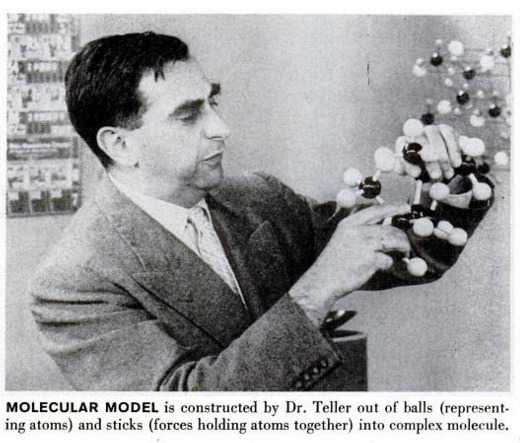On the history of nuclear weapons | http://blog.nuclearsecrecy.com
Don't wanna be here? Send us removal request.
Photo

I don’t really post much on here anymore (read my blog if you want more nuclear things!), but I thought I ought to put the fact that my book came out in early 2021 on here. I also think the cover is gorgeous and perfect. If you are interested, check out the website I made for it here: Restricted Data: The History of Nuclear Secrecy in the United States (University of Chicago Press, 2021). Thank you!
15 notes
·
View notes
Photo









A few of my favorite “secret” stamps from the archives.
609 notes
·
View notes
Photo

Operation Redwing, Shot Mohawk, July 2, 1956: 360 kiloton tower shot, Enewetak Atoll, Marshall Islands.
158 notes
·
View notes
Photo

Operation Plumbbob, Shot Fizeau, September 14, 1957: 11 kiloton tower shot, Nevada Test Site. Possibly a test of the W34 warhead, used in numerous tactical nuclear weapons.
126 notes
·
View notes
Photo

Chesley Bonestell's imagination of a post-nuclear New York, Collier's Magazine, August 1950.
154 notes
·
View notes
Link
(I realize I forgot to post this here a few weeks ago...) It is rare I get to write about two of my obsessions — stray dogs and nuclear missiles — but the anniversary of Sputnik 2, and Laika, the first animal in space, gave me such an opportunity...
66 notes
·
View notes
Link
Today is the 75th anniversary of the Pile, the world’s first nuclear reactor, going critical. This is my take on its legacy.
100 notes
·
View notes
Photo










The Hiroshima Peace museum had many powerful images to illustrate the destruction and human cost of the use of the atomic bomb. But it's this guy and his students of the Noboricho Elementary School, located 0.7 mi / 1.1 km from ground zero, that I keep thinking about. Those smiles seem to transcend politics.
Records of school children provided a key dataset for calculating the casualty-distance curves of the atomic bombs. There’s something so, soo dark about that.
250 notes
·
View notes
Photo




In 1955, Edward Teller — “father of the hydrogen bomb” — tried his hand at children’s science programming. It apparently didn’t work out. His facial expressions are amazing here — from “wtf am I doing here” to “time to get back to designing superweapons, kids.” Photos and captions from LIFE magazine.
94 notes
·
View notes
Photo









72 years ago today: The first nuclear detonation lights up the early morning desert in New Mexico, with the power of 20,000 tons of TNT. Above: some of my favorite, unusual photographs from the Los Alamos archives. For more, you can also read my New Yorker article from two years ago: “The First Light of Trinity.”
234 notes
·
View notes
Video
youtube
Street life in Hiroshima, 1935, aka 10 years before the atomic bomb attack. Puts places and faces to all those photos of a desolated wasteland. At 2:25 it pans upwards past the Aioi Bridge, the atomic bomb’s aiming point. What would later be called the "A-bomb dome” — then, a museum of commerce and industry — is on its the right.
26 notes
·
View notes
Photo




Some really wonderful pen-and-paper illustrations by Tom Hertzberg from the Bulletin of the Atomic Scientists, circa the late 1980s.
120 notes
·
View notes
Photo

Cold War dosimeters, by Bendix. These are pen-sized radiation detectors that require no power. If you hold them up to the light and look through them like a telescope, you see a tiny little radiation gauge with a thin wire indicating the current setting. Exposure to ionizing radiation moves the wire. So you’d measure your starting reading (say, “5 Roentgens”), and then wait an hour, then check again (say, “6 Roentgens”) and then you’d know that wherever you had been had exposed you to 1 R/hr of radiation (radiation workers in the US are allowed to have about 5 R per year exposure, to put the numbers in contrast; about 500 R in a short dose will kill you, 100 R will make you quite sick, and below that you are just adding to your lifetime cancer risk by a small amount). They are entirely passive and require no electricity or anything to operate — very low-tech high-tech.
There is also a device that comes with them to reset them back to 0 again.
269 notes
·
View notes
Photo

“Keep her in the dark about military secrets” — US World War II propaganda/OPSEC poster. From the National Archives and Records Administration.
34 notes
·
View notes
Photo

A photo I took of 1WTC yesterday, when it was half-enveloped in fog and cloud...
47 notes
·
View notes
Photo

USAF Launch Officer practices launching an ICBM, February 2016 — probably not the image you had of a nuclear missileer?
1st Lt. Pamela Blanco-Coca, 319th Missile Squadron missile combat crew commander, and her deputy commander, 2nd Lt. John Anderson, simulate key turns of the Minuteman III Weapon System Feb. 9, 2016, in a launch control center in the F.E. Warren Air Force Base, Wyo., missile complex. When directed by the U.S. President a properly conducted key turn sends a "launch vote" to any number of Minuteman III ICBMs in a missileer's squadron, with two different launch votes enabling a launch. (U.S. Air Force photo by Senior Airman Jason Wiese)
Source (cropped)
36 notes
·
View notes
Link
I helped research (and am interviewed on) this new episode of Radiolab about US nuclear weapons and who can (or should) be able to use them.
18 notes
·
View notes